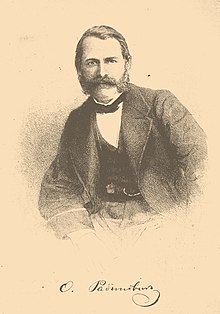Osip Rabinovich
Osip Aaronovich Rabinovich | |
|---|---|
 Portrait of Rabinovich, date and artist unknown | |
| Born | 26 January 1817 Kobeliaky, Poltava Governorate, Russian Empire |
| Died | 28 October 1869 (aged 52) Merano, Tyrol, Austro-Hungarian Empire |
Osip Aaronovich Rabinovich (26 January [O.S. 14 January] 1817 - 28 October [O.S. 16 October] 1869) was a Russian-Jewish writer, journal, and belletrist. He is notable as the founder of the first Jewish journal published in Russian.
Life
[edit]Rabinovich was born in Kobeliaky on 26 January [O.S. 14 January] 1817 to a well-off family. His father gave him an education in not only Hebrew, but in European languages, history, mathematics, art, and music.[1] He was married at age 18. In 1840, he went to study in Kharkiv. Rabinovich desired to study law, but the laws of the time banned Jews from studying law; instead, he studied medicine. In Kharkiv, he met the poet Nikolay Shcherbina; they would later go on to become good friends, with Rabinovich helping Shcherbina to publish his poetry, and one of the characters in his novel Kaleidoscope being inspired by Shcherbina.[2] Rabinovich could not complete his studies in Kharkiv, as he needed to financially support his father. In 1845 he moved to Odesa and began to work as a notary.
He published his first literary work in 1847, a translation of Jacob Eichenbaum's work Ha-Kerav into Russian. He published a novel, Moritz Sefardi, in 1850; and wrote short stories as well. He was compared in style to Dmitry Grigorovich. He drew controversy from the Jewish community for his articles criticizing Jewish society; however, he also wrote articles criticizing Russian antisemitism.
He was the founder and co-editor (alongside Joachim Hayyim Tarnopol) of the first Jewish journal in Russian - Rassvet (Russian: Рассвет, lit. 'The Dawn') The journal began publication in 1860, with contributors such as Lev Levanda and Isaac Markus Jost. However, it faced struggles due to strict government censorship,[3] and lasted only 1 year, as they were made to cease publication by the government.[4] The journal was passed to others, where it was published under the name Sion and published for another year.[3] Here Rabinovich's literary activity ended. In his later years, he suffered from poor health, and went to Merano in Tyrol to convalesce. There he died of tuberculosis on 28 October [O.S. 16 October] 1869.[5]
As a writer, he was completely forgotten.[1]
Bibliography
[edit]- "RABINOVICH (RABBINOWITZ), OSIP AARONOVICH". Jewish Encyclopedia. Funk & Wagnalls. 1906. Retrieved 23 March 2024.
- Safran, Gabriella (2007). "Rabinovich, Osip Aronovich". YIVO Encyclopedia. Yale University Press. Retrieved 23 March 2024.
- Ignat'yev, N.D. (1910). "Рабинович, Осип Аронович" [Rabinovich, Osip Aronovich]. Russian Biographical Dictionary (in Russian). Vol. 15. Russian Historian Society. Retrieved 23 March 2024.
- Izrailson, Yakov Izrailevich (1898). "Рабинович, Осип Ааронович" [Rabinovich, Osip Aaronovich]. Brockhaus and Efron Encyclopedic Dictionary (in Russian). Vol. 25a. Retrieved 23 March 2024.
- "Рабинович, Осип Аронович" [Rabinovich, Osip Aronovich]. Granat Encyclopedic Dictionary (in Russian). Vol. 29. 1934. Retrieved 23 March 2024.
References
[edit]- ^ a b Markish, Simon; Négrel, Dominique (1980). "Osip Rabinovič". Cahiers du Monde russe et soviétique (in French). 21 (1): 5–30. doi:10.3406/cmr.1980.1371. ISSN 0008-0160. JSTOR 20169869. Retrieved 17 February 2024.
- ^ "Щербина, Николай Федорович" [Shcherbina, Nikolay Fyodorovich]. Russian Biographical Dictionary (in Russian). Vol. 24. 1912. Retrieved 16 February 2024.
- ^ a b Klier, John D. (1986). "1855-1894 Censorship of the Press in Russian and the Jewish Question". Jewish Social Studies. 48 (3/4): 257–268. ISSN 0021-6704. JSTOR 4467340. Retrieved 17 February 2024.
- ^ Haruv, Dan (2008). "Razsvet". YIVO Encyclopedia. Translated by David Fachler. Yale University Press. Retrieved 16 February 2024.
- ^ Markish, Simon; Négrel, Dominique (1980). "Osip Rabinovič [II]". Cahiers du Monde russe et soviétique (in French). 21 (2): 135–158. doi:10.3406/cmr.1980.1382. ISSN 0008-0160. JSTOR 20169884. Retrieved 17 February 2024.
